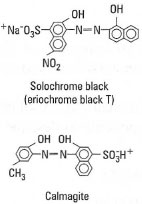The basis of a complexometric titration involving EDTA
The metal ion under investigation is bound to an indicator in solution (under strict pH control). This solution is then titrated against a standard solution of EDTA. This can be expressed in the form of an equation:⇒Equation [23.1]
| Metal-indicator + EDTA → metal-EDTA + indicator |
Stability of complexes
The thermodynamic stability of a species is an indication of the extent to which that species will be formed (under certain conditions and provided that it is allowed to reach equilibrium).
As an example consider the general case of a metal, M, in solution together with a monodentate ligand, L. It is possible to describe this system in terms of step-wise equilibria:
| ⇒Equation [23.2] | M + L = ML | K1 = [ML]/[M][L] | |
| ⇒Equation [23.3] | ML + L = ML2 | K2 = [ML2]/[ML][L] |
Or, in general terms:
| ⇒Equation [23.4] | ML(n − 1) + L = MLn | Kn = [MLn]/[ML(n − 1)][L] |
where K1, K2,··· Kn are step-wise stability constants.
An alternative approach for expressing the equilibria might be as follows:
| ⇒Equation [23.5] | M + L = ML | β1 = [ML]/[M][L] | |
| ⇒Equation [23.6] | M + L2 = ML2 | β2 = [ML2]/[M][L]2 |
Or, in general terms:
| ⇒Equation [23.7] | M + Ln = MLn | βn = [MLn]/[M][L]n |
where β1, β2, ... , βn are the overall stability constants and are related to the step-wise stability constants as follows:
| ⇒Equation [23.8] | βn = K1 × K2 × Kn |
Factors influencing the stability of complexes
The stability of a complex is related to the ability of the metal ion to complex with a given ligand, and to the characteristics of the ligand.
End-points can be determined more easily when a single complex is formed rather than when the complex is formed in a step-wise fashion. This can be achieved by using the aminopolycarboxylic acid, EDTA (Fig. 23.2).
In equations, EDTA can be expressed as H4Y. The disodium salt Na2H2Y is frequently used as a source of the complex-forming ion, H2Y2−. Thus the typical reaction of EDT A with a metal ion can be written in the following form:
| ⇒Equation [23.9] | M2+ + H2Y2− → MY2 + 2H+ |
The reaction of a metal ion with EDT A is always in the ratio I: I. The stability constants of selected metal-EDTA complexes are given in Table 23.1.
 |
| Fig. 23.3 Examples of metal-ion indicators: solochrome black and calmagite. |
 |
| Table 23.1 Stability constants of selected metal-EDTAcomplexes (expressed as log K)* |




